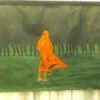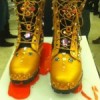In the UK, Canada, and the USA public libraries are under threat of reduced funding, outright defunding, and total closure. Increasingly, authors are inserting themselves into public discussions of the future of libraries. In Toronto, Margaret Atwood helped prevent drastic cuts to the city’s library budget, but only after a local politician, the brother of Mayor Rob Ford, made a fool of himself. According to the Toronto Star, upon learning that Atwood had urged Torontonians to let City Council know of their determined support for libraries, Councillor Doug Ford
“said that the literary icon and activist—who took him to task on Twitter for saying, erroneously, that his Etobicoke ward has more libraries than Tim Hortons [coffee shops]—should get herself elected to office or pipe down. ‘Well good luck to Margaret Atwood. I don’t even know her. If she walked by me, I wouldn’t have a clue who she is,’ said the councillor and advisor to his brother, Mayor Rob Ford, after a committee meeting on proposed cuts. ‘She’s not down here, she’s not dealing with the problem. Tell her to go run in the next election and get democratically elected. And we’d be more than happy to sit down and listen to Margaret Atwood.’”
What followed was an outpouring of support for Atwood so pronounced that both Fords have since backed off of their effort to close Toronto libraries.
Aggressive know-nothingism is also found among American politicians. In 2000 Senator Hillary Clinton referred to E.B. White in a debate during her campaign for re-election. Incredibly, then-Governor George Pataki told media in the post-debate spin room said, “It doesn’t sound to me like that guy was a New Yorker or understood New York the way we do.”
The future of libraries is especially dire in Britain, due to the severe austerity imposed by David Cameron’s government, hitting all sectors of British society, from schools to rubbish pick-up to recreation to the libraries. This week, author Jeannette Winterson gave an impassioned speech at the British Library where she called for dragooning tax revenues due from the UK divisions of Amazon, Google, and Starbucks to support the country’s endangered library systems. Controversy has attached to those three companies over their apparent efforts to park profits from their UK operations in offshore tax havens. According to The Guardian’s report, Winterson took a very personal turn toward the end of her remarks.
She ended by telling the story of how she discovered TS Eliot in her local library in Accrington, aged 16 and about to be thrown out of the house by her mother “for breaking a very big rule – the rule was not just No Sex, but definitely No Sex with your own Sex”. Scared and unhappy, Winterson went to collect her mother’s books from the library–including Murder in the Cathedral, which her mother had assumed was “a gory story about nasty monks”. Winterson took a look, having never heard of TS Eliot, and saw it was written in verse.
“The librarian told me he was an American poet who had lived in England for most of his life. He had died in 1964, and he had won the Nobel prize. I wasn’t reading poetry because my aim was to work my way through ENGLISH LITERATURE IN PROSE A-Z. But this was different. I read: ‘This is one moment/ But know that another/ shall pierce you with a sudden painful joy.’ I started to cry,” she said.
She went outside and read the whole thing, sitting on the steps. “The unfamiliar and beautiful play made things bearable that day, and the things it made bearable were another failed family–the first one was not my fault but all adopted children blame themselves,” she said. “The second failure was definitely my fault. I was confused about sex and sexuality, and upset about the straightforward practical problems of where to live, what to eat, and how to do my A-levels. I had no one to help me, but TS Eliot helped me. I had no one to help me, but the library helped me. That’s why I’m here tonight.”
 Readers of this blog will recall that I contributed an essay, “Remembering Mr. Stress, Live at The Euclid Tavern,” to Rust Belt Chic: A Cleveland Anthology. Co-editor Anne Trubek reports that the book is selling well, in its ebook and trade paperback editions, and is frequently being reordered by book retailers including Amazon.com. Anne posted news on Facebook tonight that the Nook, Apple, and Kindle ebook editions are right now being sold in the respective digital stores for the terrific price of $2.99 (Nook store, ITunes store, and Kindle store)
Readers of this blog will recall that I contributed an essay, “Remembering Mr. Stress, Live at The Euclid Tavern,” to Rust Belt Chic: A Cleveland Anthology. Co-editor Anne Trubek reports that the book is selling well, in its ebook and trade paperback editions, and is frequently being reordered by book retailers including Amazon.com. Anne posted news on Facebook tonight that the Nook, Apple, and Kindle ebook editions are right now being sold in the respective digital stores for the terrific price of $2.99 (Nook store, ITunes store, and Kindle store)















